
© 2010-2022 by Fine Arts of the Southwest, Inc. All rights reserved.
Unauthorized reproduction or use is strictly prohibited by law.
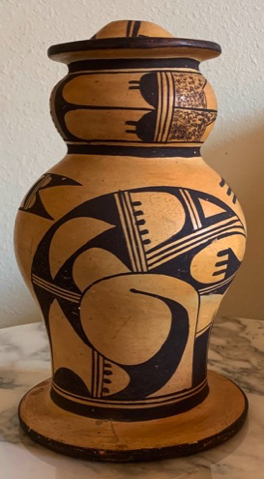
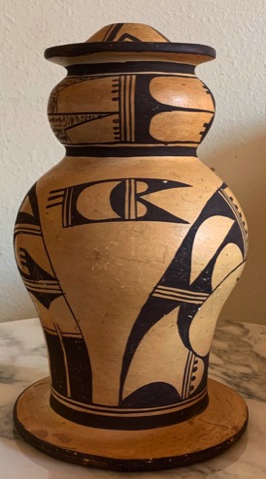
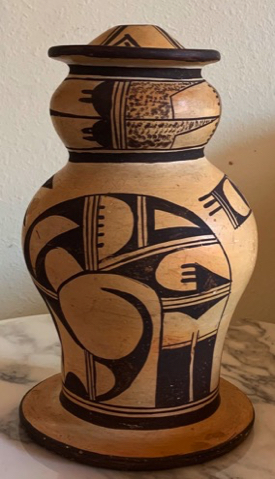
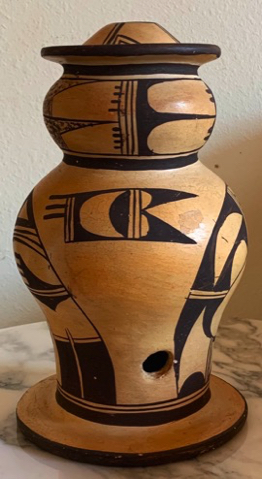
An extremely rare and unusual Hopi black-on-yellow pottery table lamp attributed to Paqua Naha, “Original Frogwoman”, c.1920’s
The three most accomplished known Hopi potters of the early years of the 20th Century were Nampeyo of Hano (1856-1942), Grace Chappella (1874-1980) and Paqua Naha (1890-1955), who is also known as the “Original Frogwoman”, “Paqua” being the Hopi word for “frog”. These distinguished eminences would soon be joined in turn by Nampeyo’s four talented pottery-making daughters, Annie (1884-1968), Nellie (1896-1978), Fannie (1900-1981) and Daisy (1906-1994). And, in the same manner as Nampeyo before her, Paqua Naha also established an extremely distinguished family pottery-making dynasty that lives on today through her famous daughter, Helen Naha (a.k.a. “Featherwoman”,1922-1993) Helen’s sister-in-law, Joy Navasie (a.k.a. “Second Frog Woman”,1919-2012), her three grand-daughters Sylvia, Rainy and Burel Naha and her great-grandaughter, Tyra Naha.
As we confirmed in a telephone discussion with the distinguished historic Hopi pottery authority, Dr. Edwin L. Wade, this splendid Hopi black-on-yellow pottery lamp is clearly identifiable as being a piece of Paqua Naha’s work in that it bears a number of the distinct and distinguishing characteristics of Paqua Naha’s early pottery pieces; similar in some ways and certainly equivalent in quality and beauty to the pottery of Nampeyo, but markedly different in certain elements of design style and execution. Paqua generally preferred bold stylized Hopi design motifs rendered in a deep, rich, strong black paint which literally pushed out the boundaries of the vessel walls and she had a distinct preference for making black-on-yellow as opposed to polychrome pottery vessels, particularly early in her career. Her early vessels are always possessed of a deep strength, vitality and intensity. The shape of this vessel is simply marvelous, a stacked double or even triple-lobed presentation. The dramatic shape is most beautifully accentuated by a series of different design bands around the body of the lamp beginning with large stylized vertical bird forms on the lower section.
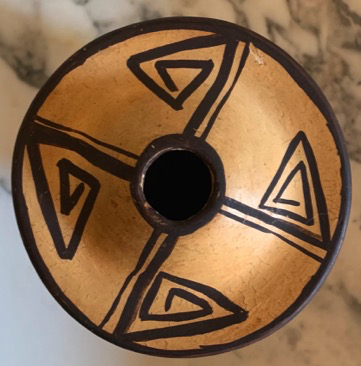
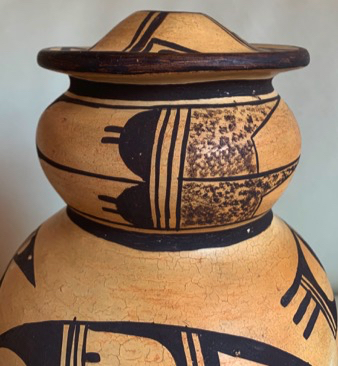
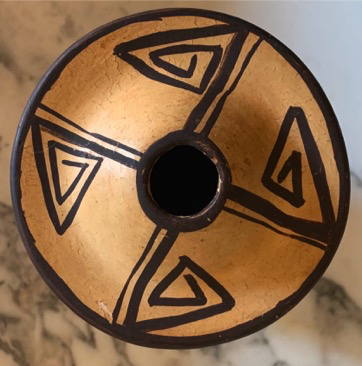
The second upper panel consists of a horizontal geometric arrangement of stylized feather tip designs and the third, very top panel of the lamp is an extremely striking, almost art deco presentation of a four-part Hopi migration symbol. The designs work beautifully individually and they are even more attractive, almost symphonic in their impact together in the aggregate. In addition to the excellent painting, the overall quality of the potting and polishing and the very hard to achieve high-temperature Lignite coal-firing in evidence here is absolutely superb and completely consistent with Paqua’s consummate artistry and superior craftsmanship.
“Nampeyo’s international fame as a ceramicist unfortunately has overshadowed the brilliance of a number of other early 20th Century Hopi potters and especially true of the equally talented Paqua Naha, Frog Woman (1890–1955). Paqua preferred simple but oversized dynamic motifs as with the pendant swirling “migration”, design emphasized here, symbolic of the original dispersal of the people from the underworld. Such free floating design units are Hopi inspired but resonate with the geometric force, power, of the Western artistic tradition of Art Deco, which she beautifully had mastered.”
-Edwin L. Wade, Ph.D.
This particular pottery lamp is an unusually rare and unique historic example for any number of reasons. In the first place, Hopi pottery lamps are exceedingly rare in general, we have seen only five or six of them in all over the past 35 years and all of those were much later pieces made in the 1940’s and 1950’s. Until acquiring this particular piece, we have never before seen or had a Hopi pottery lamp from this very early time period, let alone one of this exceptional beauty and quality from the hand of such a distinguished artist as Paqua Naha. Accordingly, as a basically non-Hopi functional ceramic form (The Hopi of this time period did not customarily use electric table lamps in their dwellings.) it is fairly natural to surmise that this piece would have almost certainly been made to order as a special commission from a prominent Indian trader in the local Hopi area of Northern Arizona such as Juan Lorenzo (J.L.) Hubbell or Thomas Varker Keam possibly for an important client, possibly for use in a Fred Harvey Company/Santa Fe Railroad hotel or trading post such as the nearby El Tovar or Hopi House at The Grand Canyon or possibly for sale to a client for their personal home use.
This likelihood is nicely evidenced by the faded remnants of an old paper Fred Harvey Company style rectangular
price sticker on the shoulder of the lamp as seen below at right and it also dovetails well with the informal oral “campfire”-type history that we have on the piece, which while not literally documented, fits perfectly into the right
time framework and circumstances and the appropriate general geographic area.
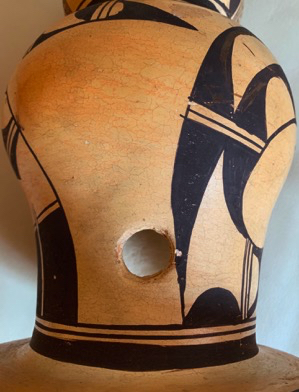
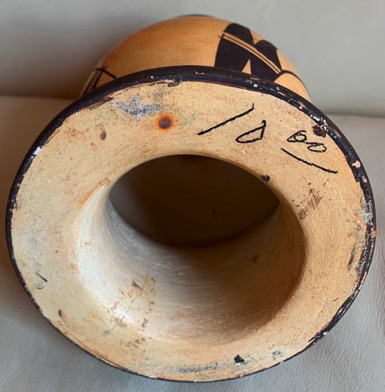
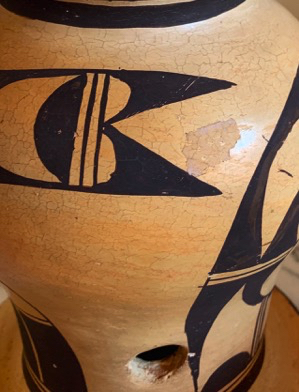
The lamp was recently acquired from a gentleman who inherited it from his Grandparents who had traveled widely throughout the Southwest in the 1920’s and 1930’s. He was told that they purchased this lamp at a trading post somewhere in Arizona sometime in the late 1920’s. The price of “$10.00” handwritten in old black grease pencil on the bottom of the lamp also fits properly into this narrative and time frame; ten dollars was a considerable amount of money for a piece of Native American pottery in the late 1920’s befitting this lamp’s exalted status as a very difficult to make, beautiful and desirable object made by a well-known and important maker. Interestingly, the lamp’s purchasers never had it fitted and wired for use as a lamp preferring instead to keep and admire it as the beautiful sculptural and decorative object it is, so essentially it has never been used or fitted as a lamp although it could quite easily be fitted as one at anytime, if ever desired, at a fairly reasonable cost of no more than a few hundred dollars by a qualified lamp maker. This lack of functional household use likely accounts for the generally excellent original condition of this nearly 100-year-old pottery vessel.
The vessel measures a good-sized 11” in height and it is approximately 6 1/2” in diameter at its widest point, It is in generally excellent original condition with a few minor scuffs and dings here and there, some slight, completely normal surface cracking and a small crack extending up from the base about three inches. It is unsigned as Paqua Naha’s early vessels aways are. In later years, beginning around the late 1930’s, Paqua developed and began signing her pottery vessels with her now-famous frog with its toes pointing upwards signature, variations of which her descendants continue using to this day. This lovely pottery lamp is an exceedingly rare and remarkable piece by a renowned historic artist and it will light up your life considerably even if you never actually plug it in or turn it on.
Price $2,900
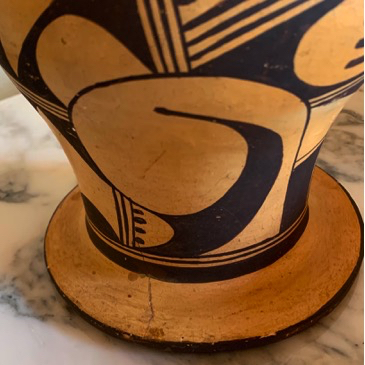
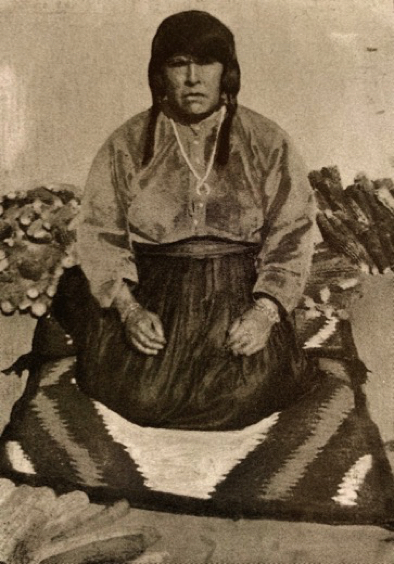
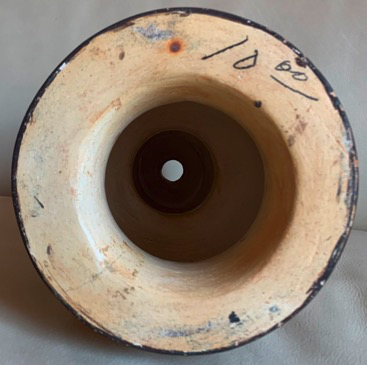
Paqua Naha, c. 1945?
Photo source and © Rick Dillingham, "Fourteen Families in
Pueblo Pottery", University of New Mexico Press, 1994, pp.62